Overview
- Brief Narrative
- Forced March No. 2. is a welded sculpture created by Peter Dallos in 2001. It depicts Jews being herded along a narrow Budapest street, a scene he witnessed as a 10 year old. It is one of nine works in The War Series, created from 1988-2012. Each work has small, thin brass rods carefully positioned in the forbidding sculptural environment that often represent Peter and his parents, as well as all those victimized by the war and the Holocaust. Hungary was a close German ally, and had enacted anti-Jewish laws since the 1930s. In 1940, Peter's father and uncles were deported to forced labor camps. But after the defeat at Stalingrad, Hungary sought a separate truce with the western Allies. To thwart these efforts, Germany occupied Hungary on March 19, 1944, when Peter was ten years old. They immediately began to systematically deport all Jews to concentration camps. Peter's father Erno was deported to a labor camp in Serbia. Peter and his mother Marie had to wear Star of David badges and move into a Jews only building. In August, Marie acquired two protective passes issued by the Swedish Red Cross which exempted them from deportation. By October, the Jews in Budapest were the last remaining Jews in Hungary. On October 15, a German orchestrated coup brought the antisemitic, fascist Arrow Cross Party to power and deportations increased. In November, Peter and Marie moved into a Swedish protected house. In December, during the siege of Budapest, there was no electricity, gas, or water, and no glass in building windows. People feared starvation. The city was continuously bombed and they stayed in the standing room only cellar most of the time. In mid-January 1945, their section of the city, Pest, was liberated by the Soviet Army; Buda was freed on February 13. Peter's father did not return and they later learned that he had been killed during a death march. Nearly all of Peter's relatives in Hungary when the war began perished.
- Artwork Title
- Forced March No. 2.
- Series Title
- The War Series
- Date
-
creation:
2001
- Geography
-
creation:
Marshall (N.C.)
- Credit Line
- United States Holocaust Memorial Museum Collection, Gift of Peter Dallos
- Signature
- underside, scratched : DALLOS
- Contributor
-
Artist:
Peter Dallos
Subject: Peter Dallos
- Biography
-
Peter Deutsch (later Dallos) was born on November 26, 1934, in Budapest, Hungary, to Erno and Maria Klein Deutsch. Erno was born in 1903 to an Orthodox Jewish family and had three younger brothers, Otto, Miklos, and Sanyi, and a sister Ella, born circa 1920. Marie, born in January 1906, had a younger brother Endre, born in 1917, and a sister Klari. The couple married in 1932. Erno was an accountant for Karitex and Marie was a comptroller for Andrea Cementworks. Miklos and Sanyi left Hungary in the 1930s; Miklos for France and Sanyi for Palestine.
The Hungarian government had radical fascist elements and was closely allied with Germany. Antisemitic measures based upon the Nuremberg racial laws in Germany were passed in the 1930s. Jews lost their citizenship and were barred from many professions. By 1940, Erno was released from his job, but was employed as an accountant by several Jewish owned factories. Forced labor service was required of all able-bodied male Jews. Marie’s brother Endre was drafted as a soldier in 1940, but a new ordinance mandated that Jews could serve only as conscripted laborers, not soldiers. Hungary joined the Axis Alliance with Nazi Germany in November and participated in the military invasions of Yugoslavia and the Soviet Union in 1941. The labor brigades were placed under the command of the military and deployed on war-related construction work. In 1941, Erno and his brother Otto were mustered into a forced labor brigade. Erno was released after several months, but Otto was sent to Levocne in the Ukraine. In 1943, Erno was assigned to a forced labor camp, but again released after several months. The family received a Red Cross notice in February 1943 that Endre and his battalion had disappeared during the retreat from Russia following the battle of the Don. Peter’s paternal grandfather died of natural causes that year leaving Peter and his maternal grandfather as the only male relatives still in Budapest. There were frequent bombings and air raids. Despite the anti-Jewish measures, the family still had financial resources since Erno was employed when he was in Budapest and Marie retained her job, though she had to be paid illegally in cash by Elemer Ascher, the Jewish manager. The family learned of the Nazi system of deportations and mass killings from a journalist friend from Prague, Miklos Ternyei.
On March 19, 1944, Hungary was occupied by Germany and, in mid-May, the Germans began to systematically deport all Jews to concentration camps. On April 6, Jews had to begin wearing Star of David patches which made Peter and his mother feel acutely ashamed. They were evicted from their home and had to turn in their radio, jewelry, and other valuables, but they were able to put most of their furnishings in storage. They moved in with his paternal grandmother and aunt. The family received word that Peter’s paternal uncle Otto had died of carbon monoxide poisoning in the bakery where he worked in Ukraine. On May 13, Erno had to report to a forced labor battalion in Vac and on May 30 was transferred to Bor labor camp and copper mines in Serbia. On June 26, all the Jews had to move into so-called star buildings, marked with yellow Stars of David. The grandmother’s building was a designated star building, and Marie’s father, sister Klari, and others moved in. On August 21, 1944, a former co-worker of Marie’s obtained two protective schutzpass from the Swedish Red Cross for Marie and Peter which prevented their deportation. They had been receiving postcards from Erno, but had heard nothing since August. By October, the Jews in Budapest were the only Jews remaining in Hungary. On October 15, there was a German orchestrated coup and the fascist Arrow Cross party gained control of the government. The nyilas, Arrow Cross paramilitary guards, began frequent selections for deportation, choosing an apartment building at random and rounding up all the residents. On October 23, all woman from the ages of 16-40 were ordered to report for forced labor. Marie, Ella, and Klari reported to a sports stadium. Marie was released because her husband was in a labor camp, but Ella and Klari were deported. Marie was to return the next day, but did not go back. The searches for Jews to deport became more frequent; people were picked up off the street and there were room to room searches.
Around November 15, Marie and Peter had to move into a designated protected house for those with Swedish schutzpasses. In late December, the siege of Budapest began; there was no electricity or gas, no water, no glass in the windows. Food was scarce and people feared death by starvation. On January 9, they were marched into the ghetto where they stayed with Marie’s mother and father-in-law. There were frequent street battles and they stayed in the standing room only cellar most of the time because of the continuous bombing. Their building in the Pest section was liberated in January 19, 1945, by the Soviet Army; Buda on February 13.
At the end of March, Marie and Peter returned to their prewar apartment which for a while they had to share with the non-Jewish workers boarded there during the war. On April 28, Klara, weighing sixty pounds, ill, and filthy, returned to Budapest. With Ella, she had been deported to Lichtenwort labor camp in Austria. Ella had died in the cattle car on the trip home from the camp. Peter’s paternal uncle Sanyi, a soldier in the Jewish Brigade, British Army, visited in fall 1945 and again in January 1946. He told Marie that if she had not heard from Erno by now, he was dead, as was Endre. It later seemed likely that Erno had died during a forced march through western Hungary in November 1944.
Peter had had a passion for painting since his high school years, but given the bleak economic prospects for artists, decided to become an engineer. In 1956, following the Hungarian revolution against Soviet dominance, he emigrated to Chicago, Illinois. He received an engineering degree at the Illinois Institute of Technology, and then a Ph.D. at Northwestern University. Dallos retired in 2010 after a fifty year career at Northwestern as a professor studying and teaching about the inner workings of the ear. In 1988, he began a second career as a sculptor.
Physical Details
- Classification
-
Art
- Category
-
Sculpture
- Object Type
-
Sculpture, Abstract (lcsh)
- Physical Description
- Welded steel sculpture, partially painted black, with a thin, flat, irregularly shaped base with a set of tall, wide, rectangular building like structures on the right and left sides, separated by a flat pathway. The seven rectangular towers are of different heights with differently shaped tops, resembling roofs; some are peaked, some flat, and one is flat but titled at a sharp angle. Several of the buildings have small, inset squares near the top, resembling windows, and etched arches for doorways at the bottom. In one corner of the base is a square, fenced courtyard; inserted within the enclosure is a single, small, brass peg. Across the pathway are two pegs, inserted into a narrow, raised sidewalk lining the pathway next to one set of buildings. Inserted along the center of pathway are several dozen brass pegs arranged in a tight group. The base underside is scratched with the artist's name.
- Dimensions
- overall: Height: 10.250 inches (26.035 cm) | Width: 16.000 inches (40.64 cm) | Depth: 13.000 inches (33.02 cm)
- Materials
- overall : steel, paint, brass
Rights & Restrictions
- Conditions on Access
- No restrictions on access
- Conditions on Use
- No restrictions on use
Keywords & Subjects
- Topical Term
- Holocaust, Jewish (1939-1945), in art--Hungary. Holocaust, Jewish (1939-1945)--Hungary--Budapest--Personal narratives. Jewish artists--United States--Biography. Jewish children in the Holocaust--Hungary--Budapest--Biography. Jews--Persecution--Hungary--Budapest--Biography. War in art. World War, 1939-1945--Personal narratives, Hungarian.
- Personal Name
- Dallos, Peter.
Administrative Notes
- Legal Status
- Permanent Collection
- Provenance
- The sculpture was donated to the United States Holocaust Memorial Museum in 2012 by Peter Dallos.
- Record last modified:
- 2022-07-28 21:51:29
- This page:
- https://collections.ushmm.org/search/catalog/irn50265
Download & Licensing
In-Person Research
- By Appointment
- Request 21 Days in Advance of Visit
- Plan a Research Visit
- Request to See This Object
Contact Us
Also in Peter Dallos collection
The collection consists of The War Series, a group of nine semi-abstract welded steel sculptures, created by Peter Dallos (originally Deutsch) about his childhood experiences in German occupied Hungary and as a memorial to victims of the Holocaust and World War II.
Date: 1988-2012
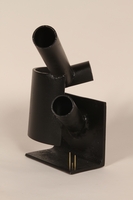
War, a minimalist welded steel sculpture symbolizing childhood memories of WWII in Budapest
Object
War is a semi-abstract, black painted steel sculpture created by Peter Dallos in 1998. It is an allegorical work that expresses the helplessness of the individual amidst the upheaval of war which Peter, as a young boy, experienced as a surreal nightmare. It is one of nine works in The War Series, created from 1988-2012. Each work has small, thin brass rods carefully positioned in the sculptural environment that often represent Peter and his parents, and all those victimized by the war and the Holocaust. Hungary, a close German ally, enacted anti-Jewish laws in the 1930s. In 1940, Peter's father and uncles were deported to forced labor camps. After the German the defeat at Stalingrad, Hungary sought a separate truce with the western Allies. To thwart these efforts, Germany occupied Hungary on March 19, 1944, when Peter was ten. They immediately began to systematically deport all Jews to concentration camps. Peter's father Erno was deported to a labor camp in Serbia. In August, Peter's mother Marie acquired two protective passes issued by the Swedish Red Cross which exempted them from deportation. On October 15, a German orchestrated coup brought the antisemitic, fascist Arrow Cross Party to power and deportations increased. In November, Peter and Marie moved into a Swedish protected house. In December, during the siege of Budapest, there was no electricity, gas, or water, and no glass in building windows. People feared starvation. The city was continuously bombed and they stayed in the standing room only cellar most of the time. In mid-January 1945, their section of the city, Pest, was liberated by the Soviet Army; Buda was freed on February 13. Peter's father did not return and they later learned that he had been killed during a death march. Nearly all of Peter's relatives in Hungary when the war began perished.
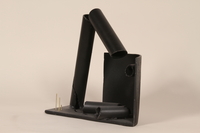
Destruction, a minimalist welded steel sculpture symbolizing childhood memories of the chaos of WWII in Budapest
Object
Destruction is a semi-abstract welded steel sculpture created by Peter Dallos in 1998/99. It represents a family fleeing from the mayhem of war. It is one of nine works in The War Series, created from 1988-2012. Each work has small, thin brass rods carefully positioned in the forbidding sculptural environment that often represent Peter and his parents, as well as all those victimized by the war and the Holocaust. Hungary was a close German ally and had enacted anti-Jewish laws since the 1930s. In 1940, Peter's father and uncles were deported to forced labor camps. But after the defeat at Stalingrad, Hungary sought a separate truce with the western Allies. To thwart these efforts, Germany occupied Hungary on March 19, 1944, when Peter was ten years old. They immediately began to systematically deport all Jews to concentration camps. Peter's father Erno was deported to a labor camp in Serbia. Peter and his mother Marie had to wear Star of David badges and move into a Jews only building. In August, Marie acquired two protective passes issued by the Swedish Red Cross which exempted them from deportation. By October, the Jews in Budapest were the last remaining Jews in Hungary. On October 15, a German orchestrated coup brought the antisemitic, fascist Arrow Cross Party to power and deportations increased. In November, Peter and Marie moved into a Swedish protected house. In December, during the siege of Budapest, there was no electricity, gas, or water, and no glass in building windows. People feared starvation. The city was continuously bombed and they stayed in the standing room only cellar most of the time. In mid-January 1945, their section of the city, Pest, was liberated by the Soviet Army; Buda was freed on February 13. Peter's father did not return and they later learned that he had been killed during a death march. Nearly all of Peter's relatives in Hungary when the war began perished.
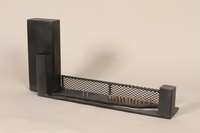
Confinement, a semi-abstract welded sculpture representing a deportation roundup
Object
Confinement is a semi-abstract welded steel sculpture created by Peter Dallos in 1999. "Confinement" depicts how prisoners selected for deportation are trapped by gates, watchtowers, and terrain that make escape impossible. It is one of nine works in The War Series, created from 1988-2012. Each work has small, thin brass rods carefully positioned in the forbidding sculptural environment that often represent Peter and his parents, as well as all those victimized by the war and the Holocaust. Hungary was a close German ally and had enacted anti-Jewish laws since the 1930s. In 1940, Peter's father and uncles were deported to forced labor camps. After the defeat at Stalingrad, Hungary sought a separate truce with the western Allies. To thwart these efforts, Germany occupied Hungary on March 19, 1944, when Peter Deutsch was ten years old. They immediately began to systematically deport all Jews to concentration camps. Peter's father Erno was deported to a labor camp in Serbia. Peter and his mother Marie had to wear Star of David badges and move into a Jews only building. In August, Marie acquired two protective passes issued by the Swedish Red Cross which exempted them from deportation. By October, the Jews in Budapest were the last remaining Jews in Hungary. On October 15, a German orchestrated coup brought the antisemitic, fascist Arrow Cross Party to power and deportations increased. In November, Peter and Marie moved into a Swedish protected house. In December, during the siege of Budapest, there was no electricity, gas, or water, and no glass in building windows. People feared starvation. The city was continuously bombed and they stayed in the standing room only cellar most of the time. In mid-January 1945, their section of the city, Pest, was liberated by the Soviet Army; Buda was freed on February 13. Peter's father did not return and they later learned that he had been killed during a death march. Nearly all of Peter's relatives in Hungary when the war began perished.
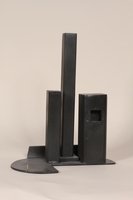
Alone, a minimalist steel sculpture symbolizing the alienated existence of a refugee
Object
Alone is a semi-abstract black painted steel sculpture created by Peter Dallos in 1988 to convey his state of mind after escaping Hungary in 1956 following the revolution against Soviet control. It is one of nine works in The War Series, created from 1988-2012. Each work has small, thin brass rods carefully positioned in the forbidding sculptural environment that often represent Peter and his parents, as well as all those victimized by the war and the Holocaust. Hungary was a close German ally and had enacted anti-Jewish laws since the 1930s. In 1940, Peter's father and uncles were deported to forced labor camps. But after the defeat at Stalingrad, Hungary sought a separate truce with the western Allies. To thwart these efforts, Germany occupied Hungary on March 19, 1944, when Peter was ten years old. They immediately began to systematically deport all Jews to concentration camps. Peter's father Erno was deported to a labor camp in Serbia. Peter and his mother Marie had to wear Star of David badges and move into a Jews only building. In August, Marie acquired two protective passes issued by the Swedish Red Cross which exempted them from deportation. By October, the Jews in Budapest were the last remaining Jews in Hungary. On October 15, a German orchestrated coup brought the antisemitic, fascist Arrow Cross Party to power and deportations increased. In November, Peter and Marie moved into a Swedish protected house. In December, during the siege of Budapest, there was no electricity, gas, or water, and no glass in building windows. People feared starvation. The city was continuously bombed and they stayed in the standing room only cellar most of the time. In mid-January 1945, their section of the city, Pest, was liberated by the Soviet Army; Buda was freed on February 13. Peter's father did not return and they later learned that he had been killed during a death march. Nearly all of Peter's relatives in Hungary when the war began perished.
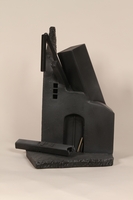
Bombardment, a steel sculpture symbolizing childhood memories of the hunt for food during the nonstop bombing of Budapest
Object
Bombardment is a welded, black painted steel sculpture created by Peter Dallos in 2000 to symbolize the desperate search for food during the siege of Budapest. All movement was restricted by the relentless bombing and the street battles between Soviet and German troops. During brief lulls in the fighting, they would run from doorway to doorway amidst collapsing buildings. It is one of nine works in The War Series, created from 1988-2012. Each work has small, thin brass rods carefully positioned in the forbidding sculptural environment that often represent Peter and his parents, as well as all those victimized by the war and the Holocaust. Hungary was a close German ally and had enacted anti-Jewish laws since the 1930s. In 1940, Peter's father and uncles were deported to forced labor camps. After the defeat at Stalingrad, Hungary sought a separate truce with the western Allies. To thwart these efforts, Germany occupied Hungary on March 19, 1944, when Peter was ten years old. They immediately began to systematically deport all Jews to concentration camps. Peter's father Erno was deported to a labor camp in Serbia. Peter and his mother Marie had to wear Star of David badges and move into a Jews only building. In August, Marie acquired two protective passes issued by the Swedish Red Cross which exempted them from deportation. By October, the Jews in Budapest were the last remaining Jews in Hungary. On October 15, a German orchestrated coup brought the antisemitic, fascist Arrow Cross Party to power and deportations increased. In November, Peter and Marie moved into a Swedish protected house. In December, during the siege of Budapest, there was no electricity, gas, or water, and no glass in building windows. People feared starvation. The city was continuously bombed and they stayed in the standing room only cellar most of the time. In mid-January 1945, their section of the city, Pest, was liberated by the Soviet Army; Buda was freed on February 13. Peter's father did not return and they later learned that he had been killed during a death march. Nearly all of Peter's relatives in Hungary when the war began perished.
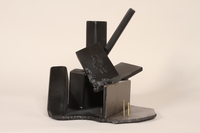
Air Raid, a semi-abstract steel sculpture resembling a bombed building based upon childhood memories of WWII in Budapest
Object
Air Raid is an abstract welded steel sculpture created by Peter Dallos in 2000. It expresses the fear of abandonment felt by a 10 year old boy of being trapped within a bombed out building, with the adults outside. The boy cannot get out and the adults cannot get to him. It is one of nine works in The War Series, created from 1988-2012. Each work has small, thin brass rods carefully positioned in the forbidding sculptural environment that often represent Peter and his parents, as well as all those victimized by the war and the Holocaust. Hungary was a close German ally and had enacted anti-Jewish laws since the 1930s. In 1940, Peter's father and uncles were deported to forced labor camps. After the defeat at Stalingrad, Hungary sought a separate truce with the western Allies. To thwart these efforts, Germany occupied Hungary on March 19, 1944, when Peter Deutsch was ten years old. They immediately began to systematically deport all Jews to concentration camps. Peter's father Erno was deported to a labor camp in Serbia. Peter and his mother Marie had to wear Star of David badges and move into a Jews only building. In August, Marie acquired two protective passes issued by the Swedish Red Cross which exempted them from deportation. By October, the Jews in Budapest were the last remaining Jews in Hungary. On October 15, a German orchestrated coup brought the antisemitic, fascist Arrow Cross Party to power and deportations increased. In November, Peter and Marie moved into a Swedish protected house. In December, during the siege of Budapest, there was no electricity, gas, or water, and no glass in building windows. People feared starvation. The city was continuously bombed and they stayed in the standing room only cellar most of the time. In mid-January 1945, their section of the city, Pest, was liberated by the Soviet Army; Buda was freed on February 13. Peter's father did not return and they later learned that he had been killed during a death march. Nearly all of Peter's relatives in Hungary when the war began perished.
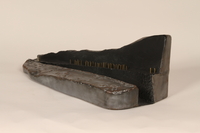
Forced March No 1., steel and brass allegorical sculpture symbolizing prisoners on a forced march into a chasm
Object
Forced March No. 1. is a welded steel sculpture created by Peter Dallos in December 2000. It represents captives being marched along a narrow cliffside road overlooking a chasm, downward, into a hell. The uneven ridge on the other side of the chasm has a polished silver surface representing a better place they will never reach. It is one of nine works in The War Series, created from 1988-2012. Each work has small, thin brass rods carefully positioned in the forbidding sculptural environment that often represent Peter and his parents, as well as all those victimized by the war and the Holocaust. Hungary was a close German ally, and had enacted anti-Jewish laws since the 1930s. In 1940, Peter's father and uncles were deported to forced labor camps. But after the defeat at Stalingrad, Hungary sought a separate truce with the western Allies. To thwart these efforts, Germany occupied Hungary on March 19, 1944, when Peter was ten years old. They immediately began to systematically deport all Jews to concentration camps. Peter's father Erno was deported to a labor camp in Serbia. Peter and his mother Marie had to wear Star of David badges and move into a Jews only building. In August, Marie acquired two protective passes issued by the Swedish Red Cross which exempted them from deportation. By October, the Jews in Budapest were the last remaining Jews in Hungary. On October 15, a German orchestrated coup brought the antisemitic, fascist Arrow Cross Party to power and deportations increased. In November, Peter and Marie moved into a Swedish protected house. In December, during the siege of Budapest, there was no electricity, gas, or water, and no glass in building windows. People feared starvation. The city was continuously bombed and they stayed in the standing room only cellar most of the time. In mid-January 1945, their section of the city, Pest, was liberated by the Soviet Army; Buda was freed on February 13. Peter's father did not return and they later learned that he had been killed during a death march. Nearly all of Peter's relatives in Hungary when the war began perished.
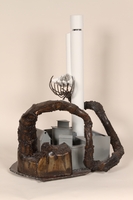
Allegorical steel sculpture made to honor Raoul Wallenberg by an artist who was one of the 1000s saved by his efforts
Object
Homage to Wallenberg is a welded steel sculpture created by Peter Dallos from 2010-2012. It is a symbolic work with an abstract representation of Wallenberg, a realistic white hand, emerging from the Jewish quarter of Budapest, cradling men, women, and children. A repulsive plant-creature, representing the Nazi menace, threatens the protected figures. It is one of nine works in The War Series, created from 1988-2012. Hungary was a close German ally, and had enacted anti-Jewish laws since the 1930s. In 1940, Peter's father and uncles were deported to forced labor camps. But after the defeat at Stalingrad, Hungary sought a separate truce with the western Allies. To thwart these efforts, Germany occupied Hungary on March 19, 1944, when Peter was ten years old. They immediately began to systematically deport all Jews to concentration camps. Peter's father Erno was deported to a labor camp in Serbia. Peter and his mother Marie had to wear Star of David badges and move into a Jews only building. In August, Marie acquired two protective passes issued by the Swedish Red Cross which exempted them from deportation. By October, the Jews in Budapest were the last remaining Jews in Hungary. On October 15, a German orchestrated coup brought the antisemitic, fascist Arrow Cross Party to power and deportations increased. In November, Peter and Marie moved into a Swedish protected house. In December, during the siege of Budapest, there was no electricity, gas, or water, and no glass in building windows. People feared starvation. The city was continuously bombed and they stayed in the standing room only cellar most of the time. In mid-January 1945, their section of the city, Pest, was liberated by the Soviet Army; Buda was freed on February 13. Peter's father did not return and they later learned that he had been killed during a death march. Nearly all of Peter's relatives in Hungary when the war began perished.



